Sottosezione - Subsection
piperatus = sapore pepato
piperatus = for acrid taste
Lactarius piperatus var. amarus
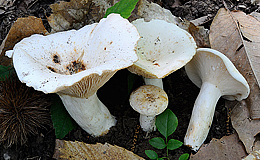
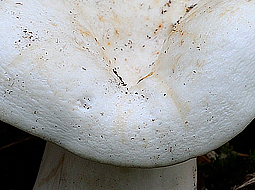
Lactarius piperatus under deciduous forest
Descrizione - Description
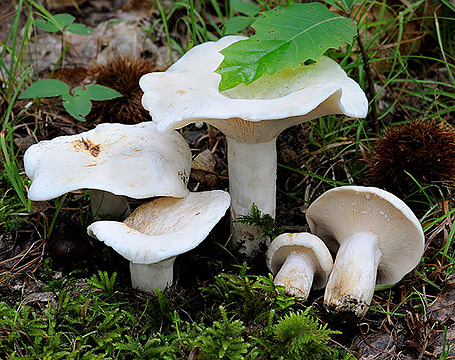
Lactarius piperatus under Castanea sativa
Cappello - Cap
30-150 (160) mm, piano-depresso, fino a imbutiforme a maturazione, spesso piuttosto
irregolare. Sodo, con margine sottile, involuto nel giovane poi piano ed infine rivolto verso l'alto; unito,
regolare o più volte ondulato e lobato, mai striato. Cuticola asciutta e opaca, con aspetto glassato
ma rugolosa e con fossette al centro, spesso screpolata e rotta con tempo asciutto, non zonata. Presenti
tipiche rughe concentriche al margine. Colore bianco, crema biancastro, spesso con macchie e punteggiature
color nocciola o ruggine ma costantemente bianco al margine.
30-150 (160) mm, plane-depressed to funnel-shaped at maturity; often rather irregular. Firm,
with thin margin, inrolled in young specimens then plane and at the end upwards; enclosed, regular or more
times undulating and lobed, never striated. Surface dry and matt, with glazed aspect but rugulose and with
pits at the centre, often broken in dry weather, azonate. Presents typical concentric wrinkles at the margin.
Color white, cream-whitish, often with spots and patches of light brown or rust but always white at the margin.
Lamelle - Gills
Lamelle molto fitte, adnate o sub-decorrenti, poi fino a decorrenti a maturazione, piuttosto
sottili e molto basse, intercalate da numerose lamellule, spesso forcute soprattutto in prossimità del gambo.
Colore crema-biancastro, crema-giallognolo, con sfumatura rosata più evidente negli esemplari giovani,
macchiate di color nocciola nelle lesioni. Filo unito, concolore. Sporata in massa bianco-crema.
Gills very crowded, adnate to sub-decurrent, then decurrent at maturity, rather thin and
narrowed with numerouse lamellulae, often forked near the stem. Cream-whitish, cream-yellowish with pinkish
tinge more evident in young specimens, stained of light brown in the lesions. Spore deposit white-cream.
Gambo - Stem
Subcilindrico, spesso attenuato in basso, rigonfio al centro nei giovani esemplari,
piuttosto irregolare con gibbosità e fossette, superficie asciutta. Pieno e sodo. Colore
biancastro con sfumature nocciola in particolare verso la base o nei punti di contatto.
Subcylindric, often attenuated at the base, enlarged at the center in young specimens,
rather irregular with gibbosity and pits, surface dry. Firm and hard. Whitish with hazelnut tinge at the base
or in points of contact.
Carne - Flesh
Soda e compatta. Colore biancastro con toni crema al taglio. Odore fruttato.
Sapore nettamante pepato.
Firm and compact. Colour whitish with cream tinge. Smell fruity. Taste very acrid.
Latice - Milk
Piuttosto abbondante, denso, bianco, immutabile isolato; sulle lamelle diviene
lentamente crema-nocciola. Sapore molto pepato.
Rather abundant, denso, white, immutable isolated; on the gills slowly
cream-hazelnut. Taste very acrid.
Macrochimica - Macro-chemical
KOH 30%: latice, cuticola e carne negativo.
KOH 30%: milk, pellis and flesh negative.
Guaiaco: verde-bluastro su carne. (Fig.1 a sinistra)
Guaiac: green-bluish on flesh. (Fig.1 on the left)
FeSO4: rosa antico su carne. (Fig.1 al centro)
FeSO4: pink-antique on flesh. (Fig.1 on the center)
Commestibilità - Edibility
Da considerare non commestibile
Not edible
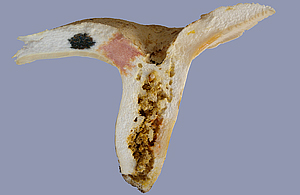
Fig. 1 - Macro-chemical reactions
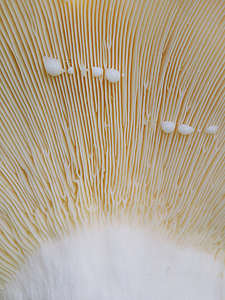
Lactarius piperatus milk and gills
Ecologia e distribuzione - Ecology and distribution
L. piperatus cresce sotto molte essenze, sia latifoglie ma anche conifere
in particolare Picea abies. E’ ampiamente distribuito in Europa anche a quote relativamente
elevate con esclusione degli ambienti artico-alpini e subartici. E’ specie molto comune ed è uno dei primi lattari
ad apparire, sin dalla tarda primavera, nelle zone a clima temperato.
L. piperatus grows grows in different forests, both decidouos that
conifers in particoular Picea abies. It's widely distribuited in Europe also at quote
rather elevated with excluding artic-alpine and subartic habitat. It's species very common and it's one
of the first lactarius to grow from late spring, in the temperate zones.
Lactarius piperatus a sinistra (left) vs Lactarius vellereus a destra (right)
Osservazioni - Discussion
Specie di grandi dimensioni, ampiamente distribuita sia in latifoglia che in
conifera e caratterizzata dal colore bianco, dalle lamelle fittissime e dal sapore assai acre. Riconoscendo qui
due specie nel Subgenere Lactarius, la specie più simile e spesso confusa è Lactarius
glaucescens Crossl. L. piperatus si differenzia da quest'ultimo per il latice che
sulle lamelle essica virando al più a crema-nocciola invece che al grigio-verde come in
L. glaucescens. Oltre a ciò, L. piperatus presenta lamelle maggiormente
decorrenti e tendenzialmente ancora più fitte oltre ad una tipica rugosità concentrica al margine del cappello.
Le reazioni macrochimiche aiutano oltremodo nella distinzione: il latice e la carne di
L. piperatus hanno reazione nulla con il KOH 30% mentre in L. glaucescens
la reazione è immediata ad arancio vivo; anche il FeSO4 sulla carne reagisce diversamente.
Microscopicamente le due specie differiscono per l'ornamentazione sporale e la conformazione della
pileipellis. Lactarius vellereus (Fr.) Fr. e Lactarius bertillonii
(Neuhoff ex Z. Schaef.) Bon possono anch'essi essere confusi con L. piperatus:
le dimensioni spesso più grandi ma soprattutto la cuticola feltrata e le lamelle piuttosto spaziate
sono buoni elementi visivi di distinzione. Anche Lactarius controversus (Pers.) Pers.
può essere confuso. La forte tinta rosa-salmone nelle lamelle di quest'ultimo aiuta al riconoscimento.
Large size species, widely distributed both in deciduous that in hardwood and characterized by
white color, by the gills very crowded and taste very acrid. Here, we recognizing two species in the subgenus
Lactarius, the species most similar and confused is Lactarius glaucescens Crossl.
L. piperatus differs from this last by milk that turns light brown on the gills instead of the
gray-greenish. Furthermore L. piperatus presents gills more decurrent and more crowded in
addition to concentric wrinkles at the margin of the cap.
Also the Macro-chemicals reactions helps in distinction: the milk and the flesh of L. piperatus
have null reaction with KOH 30% while in L. glaucescens the reaction is immediatly bright
orange; on the flesh with FeSO4 the reaction is different.
Microscopically the two species differ in the ornamentation of the spore and in the shape of the pileipellis.
Lactarius vellereus (Fr.) Fr. and Lactarius bertillonii
(Neuhoff ex Z. Schaef.) Bon may also be confused with L. piperatus but their larger size
but above the velutinous surface and the gills rather spaced are fairly good visual elements for distinguishing.
Also Lactarius controversus (Pers.) Pers. may be confused. In this case, among other things,
the strong pink-salmon tinge on the gills helps the determination.
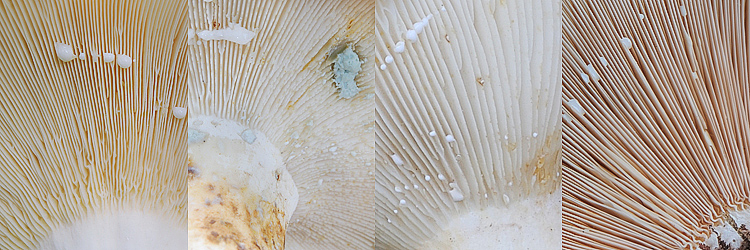
Da sinistra a destra (from left to right): L. piperatus, L. glaucescens,
L. vellereus, L. controversus
Microscopia - Microscopy
Spore - Spores
Osservate con reagente di Melzer a 1000x. Microscopio Zeiss Axio-Lab e obiettivo PlanApo
100x/1.4 in immersione ad olio. Spore 6,4-9,2 × 5,4-7,1 µm, amiloidi, largamente ellittiche con verruche e
sottili creste alte non più di 0,2 µm, a volte unite da connettivi a formare un subreticolo.
Plaga soprailare poco distinta e non amiloide.
Observed with Melzer's reagent to 1000x. Microscope Zeiss Axio-Lab and 100x/1.4
planapochromatic objective in oil immersion. Spores 6,4-9,2 × 5,4-7,1 µm, amyloid, broadly elliptical with warts
and thin ridges no more than 0,2 µm, sometimes joined by connectives to form sub-reticulate aspect.
Plage slightly distinct and inamyloid.
Basidi e Cistidi - Basidia and Cystidia
Basidi tetrasporici. Macrocistidi piuttosto numerosi, a parete spessa, da subcilindrici-flessuosi
a subfusiformi a sommità sia ottusa sia mucronati. Misure: cheilocistidi 40-55 × 7-8,9 µm e
pleurocistidi 58-81 × 8-11,5 µm. Presenti numerose cellule marginali.
Basidia 4-spored. Macrocystidia rather numerous, thick-walled, subcylindric-flexuous to
sub-fusiform with apex obtuse to mucronate. Measures: cheilocystidia 40-55 × 7-8,9 µm and
pleurocystidia 58-81 × 8-11,5 µm; aboundant marginal cells.
Pileipellis
Composta da uno strato sottile, 25-30 µm, di ife piuttosto confuse con qualche terminale
emergente e subcute composta da ife da subglobose a oblunghe.
Composed of a thin layer, 25-30 µm, hyphae rather confused with some terminal
emerging and subcutis composed of hyphae from subglobose to oblong.
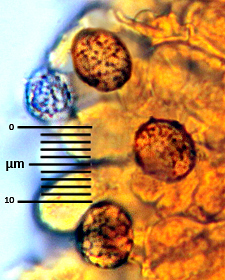
L. piperatus: spores in Meltzer reagent